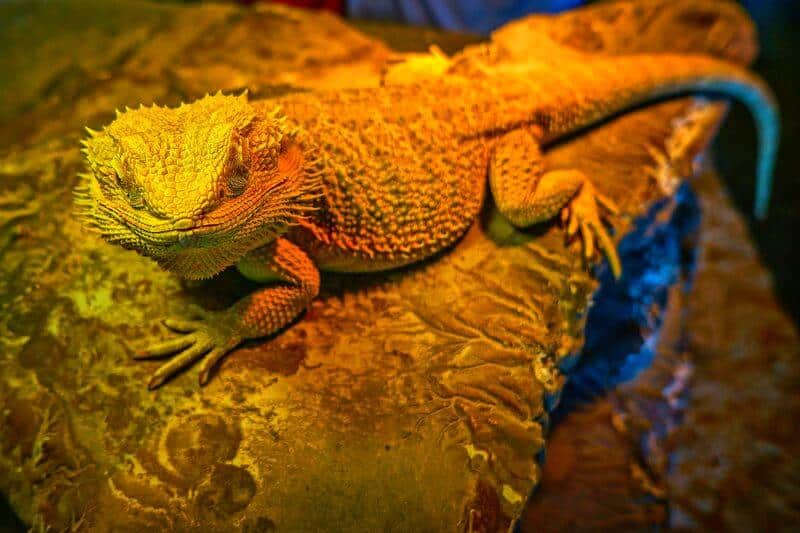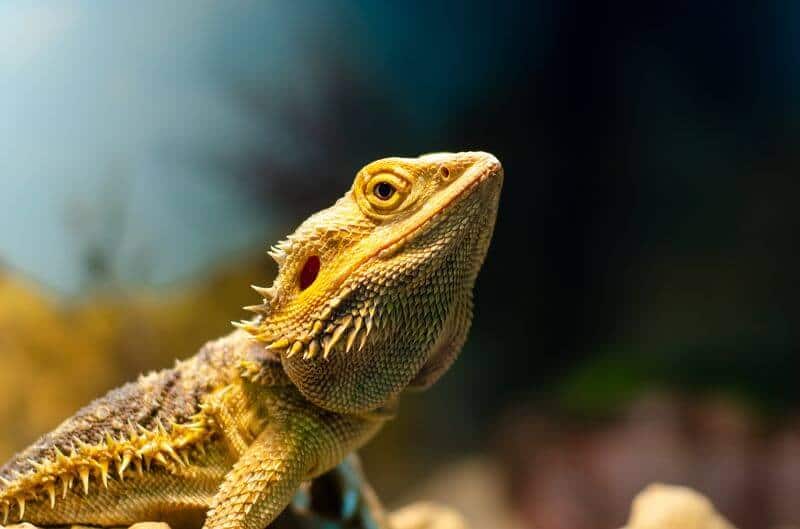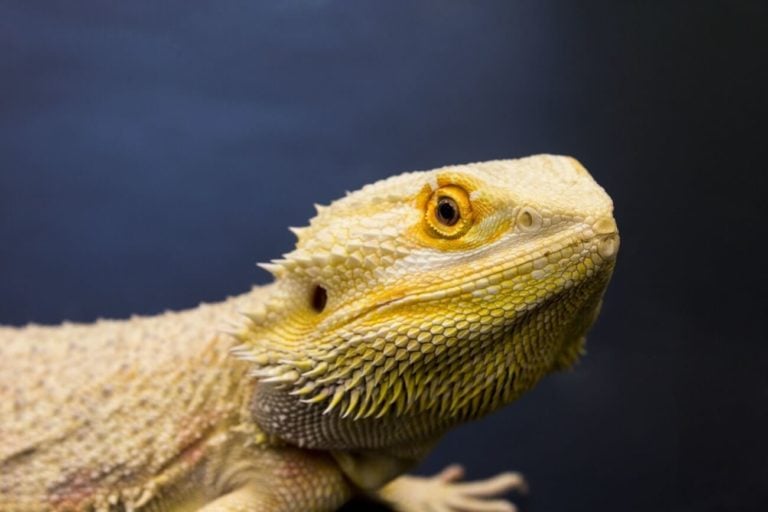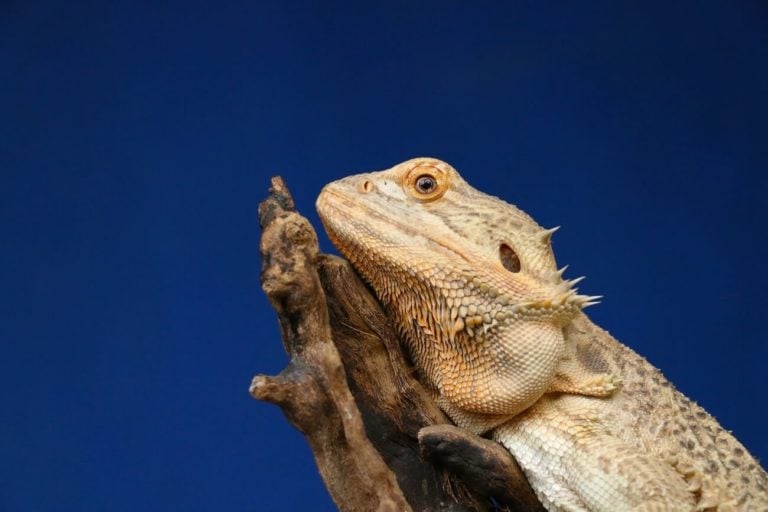Despite all of the information that’s out there about these pets, many people are still unsure if bearded dragons need heat at night or not.
This guide breaks down their heating requirements when the lights get turned off, and how to determine the right setup for your beardie.
Table of Contents
Do Bearded Dragons Need Heat At Night?
As a proud bearded dragon owner, you’re likely familiar with these animals’ basic temperature needs. These creatures are cold-blooded ectotherms and require stable temperatures to thermoregulate. Unlike warm-blooded animals, beardies can’t control their body temperature without external sources.
Therefore, they rely on basking lamps and a precise temperature gradient to thermoregulate. So that begs the question: Do bearded dragons need heat at night?
In most cases, they do not. However, it all depends on where you live and how cold it gets in your place at night.
Most owners don’t need to worry about nighttime heating in warm or even temperate climates. In these cases, bearded dragons will move throughout the temperature gradient to stay comfortable. When they’re cold, they move under the basking lamp. When they’re hot, they move to the cooler side of the enclosure.

After 14 hours or so of daylight, the lights go out. But the temperature drops very slowly. The glass walls of your vivarium act as a natural insulator, maintaining temperatures to slow down the decline at night. Pair that with moderate nighttime temperatures that bearded dragons can easily handle, and most lizards won’t need heating at night.
Bearded dragons come from arid, desert-like regions of Australia. They’re used to warm conditions during the day, but they can also tolerate the temperature swing that happens when the sun goes down. In the wild, these reptiles have no problem experiencing a 20 or 30-degree decline in nighttime temperatures.
The Exception To This Rule
As a good rule of thumb, your beardie will need heat at night when temperatures drop below 65 degrees Fahrenheit. The best thing you can do is invest in a high-quality digital thermometer. Monitor it regularly and understand the temperature changes that occur in your area.
Don’t rely on outside temperatures alone. Your home’s heating system, paired with the residual warmth of the lights, could make your bearded dragon’s habitat comfortable despite freezing temperatures outside. To get a better understanding of what your beardie needs, test the in-tank temperatures.
If it gets lower than 65 degrees Fahrenheit in the area of your home where you keep your bearded dragon, you’ll need in-tank heating at night.
Ideal Night Temperature At Night
Bearded dragons can tolerate surprisingly low temperatures. During the day, the basking spot needs to be as hot as 110 degrees. Meanwhile, the cooler side should be in the low 80s.
At night, you don’t have to worry about a temperature gradient. However, ambient temperatures within your bearded dragon’s enclosure should be between 70 and 75 degrees Fahrenheit. That’s about 21 to 24 degrees Celsius.
Bearded dragons can tolerate temperatures as low as 65 degrees Fahrenheit, but they should remain above 70 for maximum comfort. The best-case scenario is that temperatures only dip below 70 degrees at night occasionally. If it’s consistently lower than 70 degrees, it may be worth investing in additional heating sources.
Anything lower than 65 presents many problems for your bearded dragon. They can become ill, experiencing a wide range of issues like respiratory infections or mouth rot. Consistently cold temperatures at night can also trigger brumation, making your beardie lethargic for many months.
How To Keep Bearded Dragons Warm At Night
If you live in a colder climate and realize that your bearded dragon needs heat at night, you’re in luck. There are many ways to raise temperatures safely without turning on your lamps and ruining your beardies’ circadian rhythm.
1. Infrared Bulbs
Infrared bulbs are a good option for heating at night if you only need to raise the temperature by a few degrees. These bulbs are cheap and easy to find. They don’t last as long as other options, but they can be a low-cost way to keep your bearded dragon comfortable before you purchase a pricier product.
These low-wattage bulbs produce a decent amount of heat while giving off minimal light. You can get them in purple or red colors. Both options are dim, casting a gentle cone of light over the enclosure. It’s subtle enough not to ruin your bearded dragon’s sleep cycle (since they don’t need light at night), but you can also use them to observe your lizard throughout the night.
2. Heat-Emitting Ceramic Bulbs
These unique bulbs are one of the best ways to keep things warm for your bearded dragon at night. They’re cost-effective and last up to three years of regular use. You might have seen these bulbs before. They feature a standard screw-style socket base.
However, instead of glass and filament, they have a large piece of ceramic! The ceramic is opaque and produces zero light. Inside, there’s a coiled electric wire that delivers heat throughout the entire bulb.
Ceramic is a fantastic thermal conductor. The bulbs take electricity from any ordinary light socket and turn it into heat you can use to warm up your bearded dragon’s enclosure at night.
The bulbs are easy to use, and you can screw them into any existing lighting rig. Many owners like to swap out the basking lamp with the ceramic bulb at night, creating an easy setup.
3. Heating Mats
Another great option is a heating mat. As the name would imply, this accessory is a simple mat that contains built-in heating elements.
Expert Tip: What’s unique about a heating mat is that you don’t install it inside the habitat directly. Instead, you place it underneath the enclosure or on the sides of the glass.
This design is beneficial for one important reason: It’s safe. You might have seen heat-emitting rocks at your local pet store. While great for other animals, it’s not a good choice for bearded dragons.
They need to feel the heat from above. When they directly sit on a heated rock or pad, they don’t realize how hot it is until they burn.
Heating pads that you install outside the enclosure solve that problem.
If you choose to use a heating pad to keep your bearded dragon warm at night, be mindful of its placement and safety precautions. They can pose a safety issue if they make contact with flammable surfaces.
4. Heated Cables
Finally, we have heated cables. This option works on the same basic principles as a ceramic bulb or heating pad, but the cable consists of nothing more than a heating element.
The cables are insulated and resistant to water damage. As a result, you have more flexibility with placement and don’t have to worry about the effects of your bearded dragon’s high-humidity habitat.
Most reptile enthusiasts place these cables inside vivariums as large loops or tight coils. However, you can also use them externally, like a mat, to deliver heat to your bearded dragon at night.
Do Baby Bearded Dragons Need Heat At Night?
Baby bearded dragons are no different than adults when it comes to their temperature needs. If their enclosure dips below 65 degrees Fahrenheit at night, you might need to invest in additional heating systems to keep them safe.
Expert Tip: It’s wise to err on the side of caution with younger bearded dragons. Hatchlings and juveniles don’t have the developed immune systems that adults have. As a result, they’re more susceptible to illness, and colder temperatures at night exacerbate that risk.
Luckily, you can use all the same nighttime heating methods on baby bearded dragons as you would with adults.
Why It’s Important For Bearded Dragons To Be Warm Enough At Night
Improper environmental factors can lead to many health problems for bearded dragons. While they can tolerate a cool night, trouble starts when temperatures drop too low.
These reptiles can suffer from respiratory infections, viral infections, and more.
Bearded dragons also “shut down” when temperatures decrease too much. Their body goes into conservation mode, making it difficult to wake them up. Even after the sun rises, your bearded dragon may continue to sleep throughout the day or exhibit signs of extreme lethargy.
Their appetite will suffer, too.
This biological shutdown is not normal, and you must take action to warm up your bearded dragon as soon as possible. That includes raising the temperature in the enclosure, giving them a warm bath, and allowing them to sit under the basking light. If you fail to address the temperature problem, severe health problems can occur, and your beardie’s body can shut down to the point where you’ll need veterinary intervention.
Conclusion
Bearded dragons don’t normally need heat at night, but they will in certain situations. Do an honest assessment of your home and the space where you keep their enclosure, and you’ll have your answer!
If you have any questions about keeping these critters toasty at night, send us a message or reach out to us on social media. We’ll help you out the best we can!



